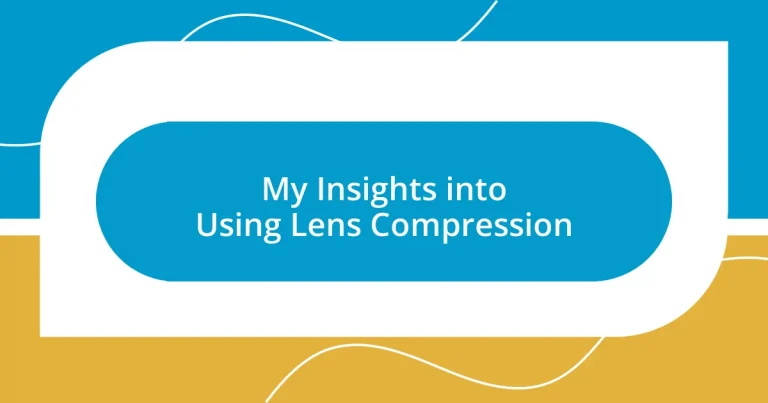Key takeaways:
- Lens compression enhances emotional storytelling by bringing elements closer together and isolating subjects, influencing the viewer’s perception dramatically.
- Common mistakes include misjudging distance, neglecting background impact, and overlooking lighting, which can distort compositions and diminish narrative quality.
- Mastering lens compression requires experimentation with focal lengths, intentional planning of shots, and harmonizing light with composition to elevate photographic storytelling.
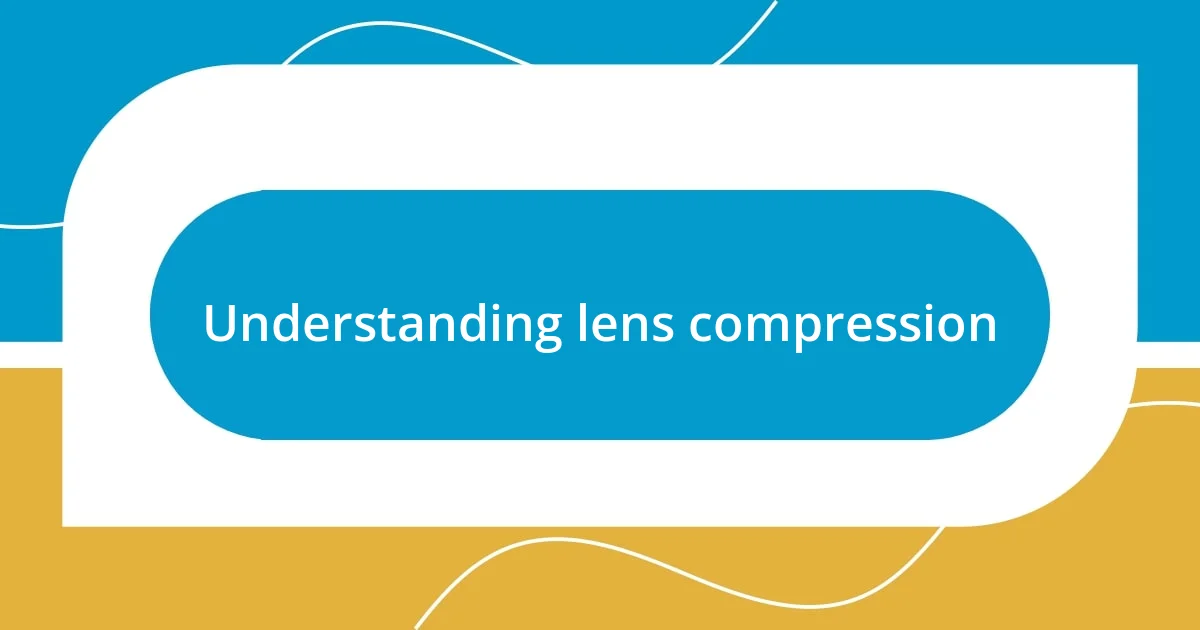
Understanding lens compression
Lens compression, a fascinating phenomenon in photography, occurs when you use telephoto lenses to capture distant subjects. I remember the first time I shot with a 200mm lens; the way it flattened the background made my subject pop like it was almost three-dimensional. Have you ever noticed how certain images seem to bring elements closer together, creating a tighter composition? That’s the magic of lens compression working its charm.
When photographing landscapes, lens compression can dramatically alter the narrative of your shot. For instance, using a longer lens allowed me to isolate a distant mountain peak against the sky, making it appear more imposing than it really was. It’s amazing how this technique can influence the emotional impact of an image—creating a sense of intimacy or grandeur simply by the choice of lens.
Understanding lens compression isn’t just technical; it’s about learning to see differently. I often find myself asking, “What story am I trying to tell?” The choice of lens becomes a tool for that storytelling, amplifying feelings or themes in my work. By recognizing and harnessing lens compression, I’ve discovered new dimensions in my photography that I hadn’t considered before.
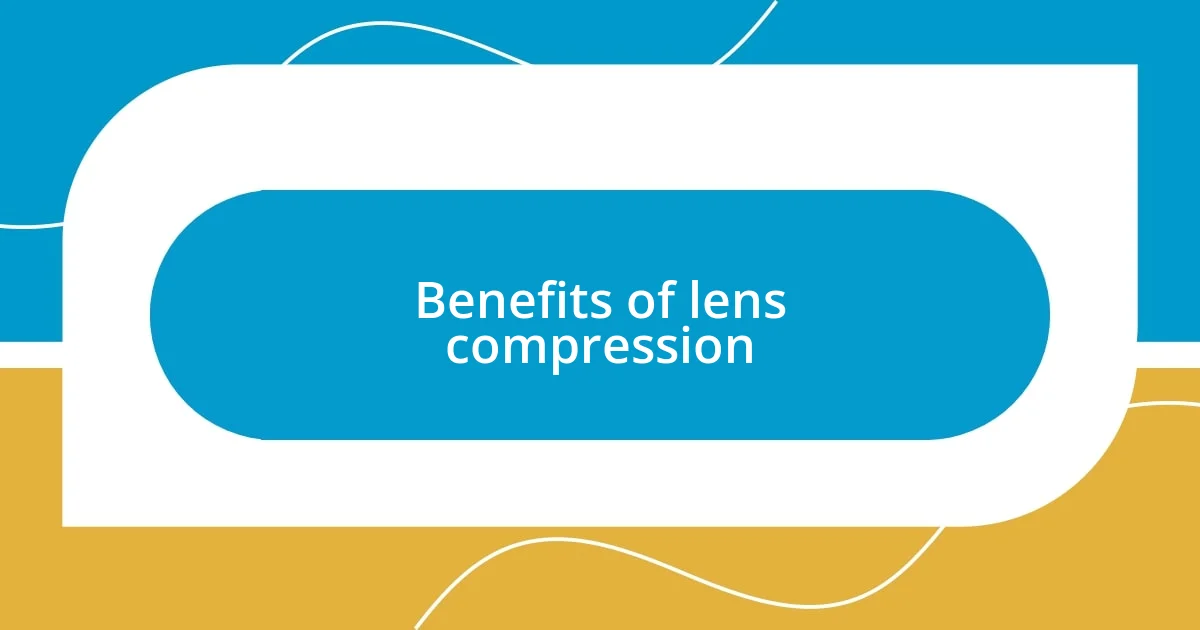
Benefits of lens compression
Using lens compression offers a myriad of benefits that can enhance your photography and storytelling capabilities. One aspect I truly appreciate is how it enables you to bring background elements closer, giving depth and dimension to your subject. For example, the first time I shot a sprawling cityscape with a 70-200mm lens, the skyscrapers seemed to rise and recede together, crafting a striking visual narrative. This technique creates a sense of intimacy that invites viewers to connect more closely with the image.
Here are some specific advantages of lens compression:
- Enhanced Subject Isolation: I’ve found that longer focal lengths beautifully isolate my subject from the background, reducing distractions and directing the audience’s attention.
- Improved Perspective Control: It allows for more creative control over how the background is arranged in relation to the subject, enhancing compositional quality.
- Increased Visual Impact: By exaggerating the scale between elements, the emotional weight of the image is often magnified, making it memorable.
- Greater Environmental Context: Although it simplifies backgrounds, it simultaneously adds context and layers that can tell richer stories.
- Flexibility in Composition: The ability to frame distant subjects tightly can lead to innovative and unexpected compositions, often pushing the boundaries of creativity.
As I’ve experimented more with different lenses, I’ve realized that lens compression isn’t just about technology; it’s about artistic expression. Each time I use it, I feel like I’m not just taking a photo but crafting an immersive experience for anyone who views it.
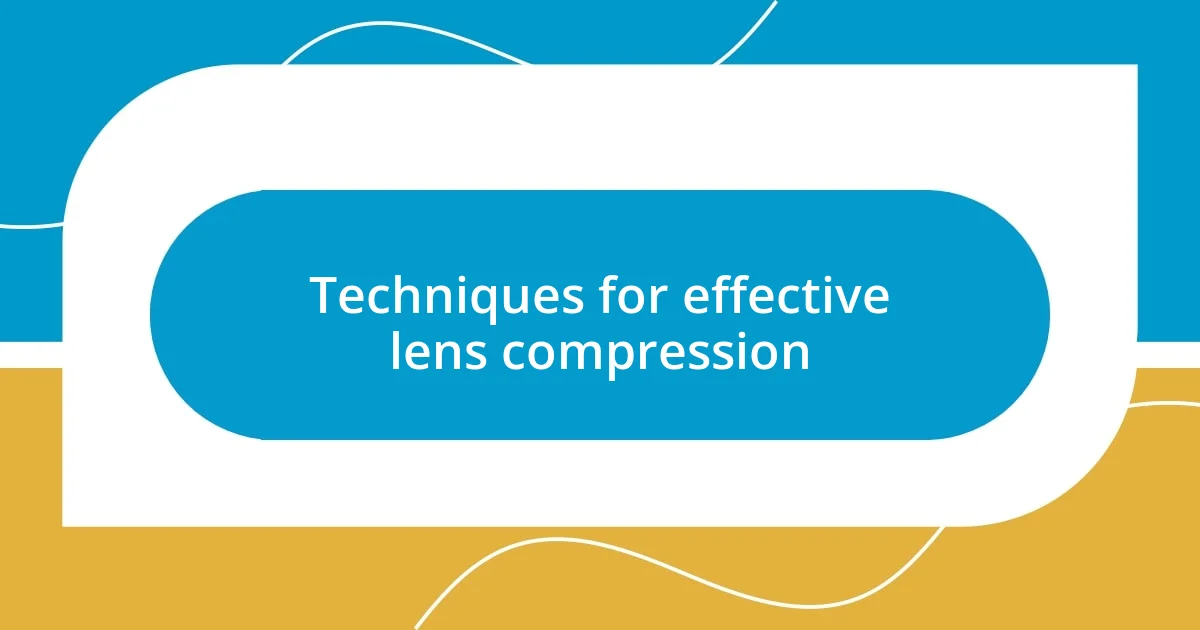
Techniques for effective lens compression
When it comes to effectively using lens compression, one technique I’ve embraced is planning my shots more deliberately. Sometimes, I’ll visualize the final image before even lifting the camera to my eye. On a recent hike, I knew I wanted to capture the cliffs in the distance. By opting for a longer focal length, I compressed the scene, transforming expansive vistas into dynamic compositions that emphasize the rugged beauty of the terrain. It’s all about anticipation; knowing how my choice of lens can alter the viewer’s perception does wonders for the creative process.
Another technique that has proven invaluable is experimenting with various angles and distances. I recall a moment during an urban photo walk where I shot a busy street using a 135mm lens. From a distance, this setup allowed me to isolate a vibrant mural while gradually blurring out the bustling city life behind—creating a remarkable juxtaposition of stillness against chaos. This approach not only enhanced my imagery but also added layers of meaning, prompting viewers to dive deeper into the story each shot tells.
Finally, utilizing the depth of field in conjunction with lens compression can amplify your subject’s prominence in photos. In one of my portrait sessions, I purposely used a 200mm lens to shoot from a distance. The resulting image completely separated my subject from vibrant, colorful surroundings, creating a serene and impactful portrayal. It’s fascinating how a simple adjustment in composition and distance can lead to such profound visual storytelling.
| Technique | Description |
|---|---|
| Planning Shots | Visualizing the final image and choosing the lens accordingly enhances creativity. |
| Experimenting with Angles | Capturing the scene from different perspectives reveals hidden narratives. |
| Depth of Field Control | Using depth of field with lens compression emphasizes the subject and shapes the story. |
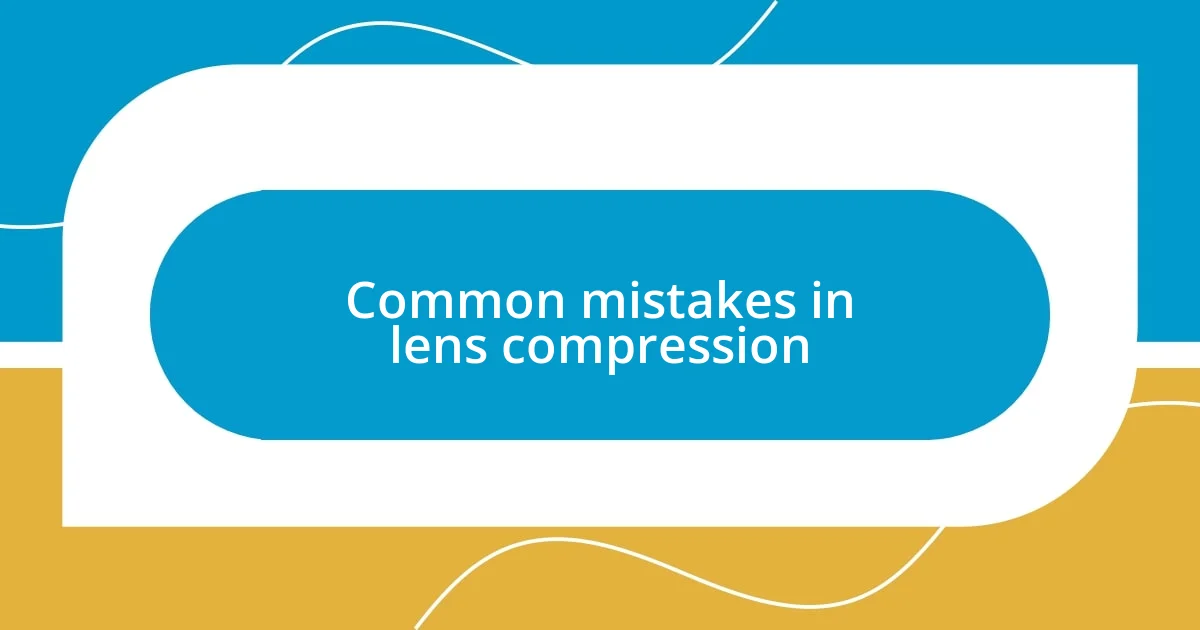
Common mistakes in lens compression
One common mistake I often see photographers make with lens compression is misjudging the distance from their subject. I’ve found that getting too close can distort proportions, leading to images that feel unbalanced. It’s a classic rookie error; I remember a time when I shot a portrait with my 70-200mm lens, thinking I could capture intimacy by moving closer. Instead, my subject’s features looked exaggerated and awkward, completely derailing the moment I intended to freeze in time.
Another frequent pitfall is neglecting to consider the background in relation to the subject. It’s easy to focus solely on what’s being compressed in the foreground while forgetting the narrative created by the backdrop. I once photographed a beautiful bride with a stunning long focal length, excited by how the floral arch framed her so well. But when I reviewed the images later, I noticed a busy parking lot behind her, which completely disrupted the ethereal vibe I aimed for. It made me realize that every element in the frame plays a crucial role.
Lastly, there’s the tendency to overlook lighting when using lens compression. I’ve caught myself deep in thought about composition while ignoring how light interacts with my subject. Once, I set up a perfect shot of a dramatic landscape, but due to the harsh midday sun, everything felt flat and lifeless. It was a humbling moment that taught me to always harmonize my lens choice with the quality of light, creating images that resonate emotionally with viewers. Don’t you want your photos not just to be seen, but to be felt? Adjusting to these common oversights can dramatically elevate your work.
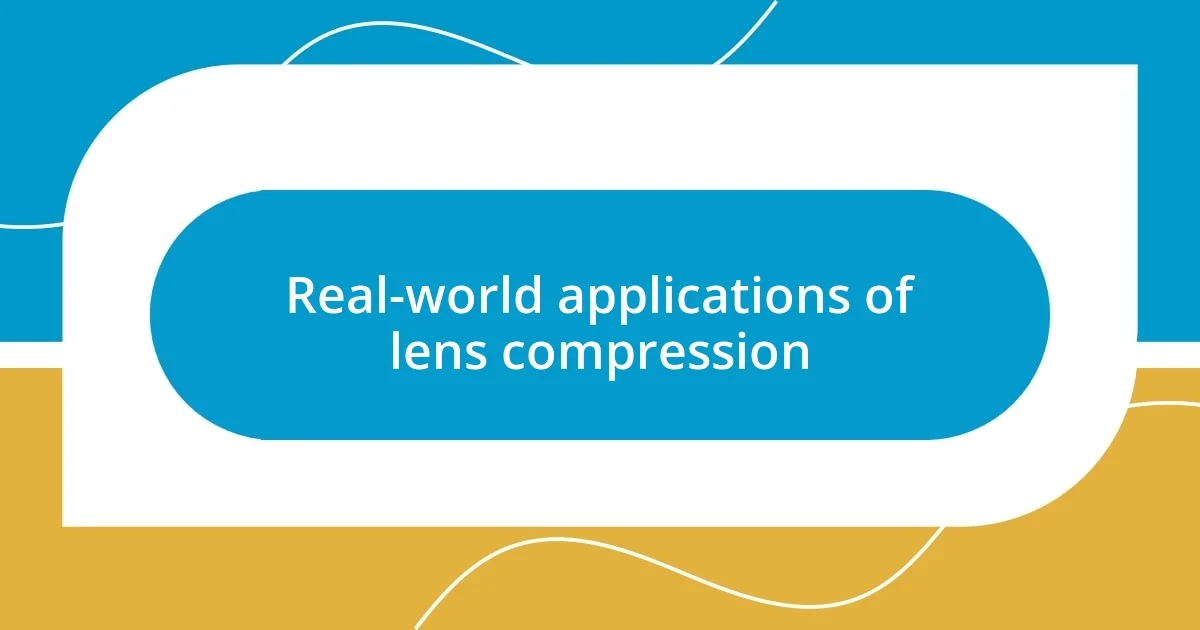
Real-world applications of lens compression
Using lens compression in real-world scenarios can yield stunning results. For instance, during a family gathering, I snapped a shot of my niece laughing while playing on the grass. By using a longer focal length from a distance, the background beautifully melted away, making her joy the undeniable focal point of the image. Isn’t it remarkable how a specific lens choice can elevate a simple moment into a heartfelt memory?
In the realm of wildlife photography, lens compression truly shines. On one exhilarating safari, I captured an elephant wandering gracefully through the savanna. With a 300mm lens, I managed to compress the vast landscape around it, highlighting the majestic creature against a backdrop that felt both far away and intimately close. I often think about how this technique allows viewers to feel the weight of the scene, drawing them closer to the subject’s experience.
Furthermore, in sports photography, lens compression can dramatize action shots. I remember vividly a local soccer match where I used a 70-200mm lens to capture players mid-kick. The depth and intensity created by compressing the action pulled viewers right into the heart of the game. Isn’t it fascinating how one decision can turn an ordinary moment into an electrifying story? Each application of lens compression offers a new way to see and feel the world through the lens.
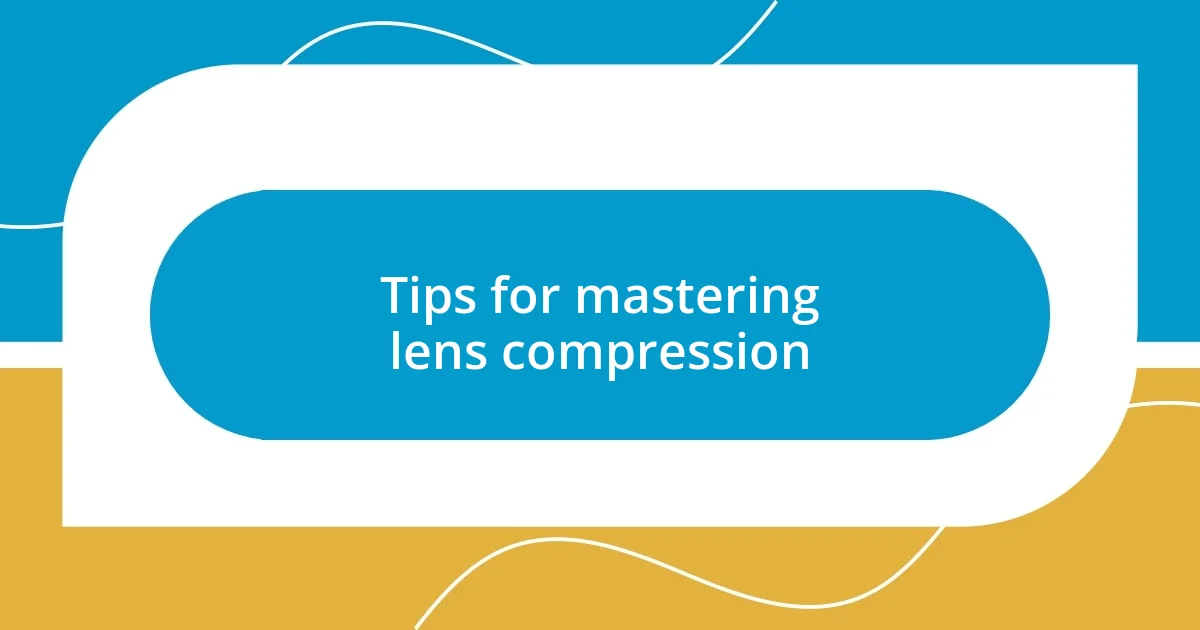
Tips for mastering lens compression
When it comes to mastering lens compression, one crucial tip is to experiment with different focal lengths. I remember a shooting session where I switched from my trusted 50mm to a 135mm lens. The transformation was striking; not only did the background compress magnificently, but the subject felt more immersive and connected to the environment. Have you ever felt that sensation of being right there, present in the moment? It’s an incredible experience that lenses can help recreate.
Another practical tip is to visualize the final composition before you even pick up the camera. I often find myself pacing the area, mentally mapping out how different lenses will interact with the scene. There was this one time I was photographing a street musician. As I mapped out potential shots with various focal lengths in my mind, I realized a 200mm lens would not only compress the background but also draw out the emotions in his performance. This approach keeps me engaged and intentional, ensuring I capture not just a picture, but a story.
Lastly, lighting is your best friend, especially when using lens compression. I’ll never forget capturing a sunset silhouette with a longer lens, where the world behind my subject melted into beautiful hues. It provided a stunning backdrop that enhanced the emotion of the moment. Have you considered how lighting plays into the narrative of your shots? When you harmonize your lens choice with the right light, it can elevate your photography from mere images to powerful visual stories.
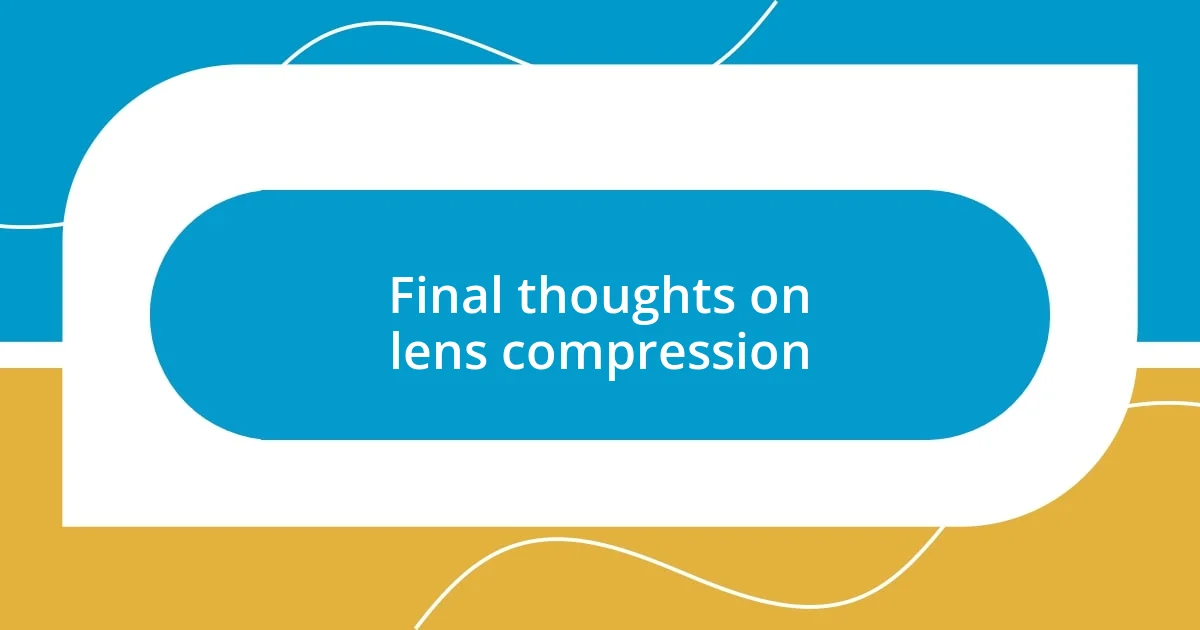
Final thoughts on lens compression
When reflecting on lens compression, I often think about how it can transform even the simplest scenes into captivating works of art. Just the other day, while taking an afternoon stroll, I decided to capture the neighborhood. Using a longer lens from across the street, I noticed how the buildings behind my subject, a child holding a balloon, seemed to expand and enhance the focus on their joy. Doesn’t it feel rewarding when a technique like this unveils layers in your images that you hadn’t originally perceived?
Another insight I’ve gleaned from my experiences with lens compression is its ability to evoke emotion. I once photographed a musician during an intimate performance at a local café. By using a 100mm lens, I was able to compress the space around him, isolating him in his passionate moment. The closer I got to the emotion, the more alive the photo felt—immediately drawing viewers into that artistic bubble. It’s amazing how a simple choice can lead to a profound connection with the viewer.
Ultimately, I see lens compression as a storytelling tool that allows me to capture life’s fleeting moments in a way that resonates with others. Think about a time you’ve experienced this in your own photography—how certain perspectives or focal lengths created an unexpected depth in your image. I truly believe that mastering lens compression opens up a world of possibilities, inviting us to see beyond the obvious and into the heart of our subjects.












